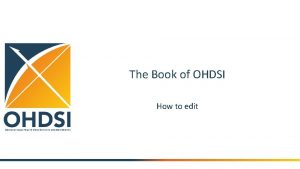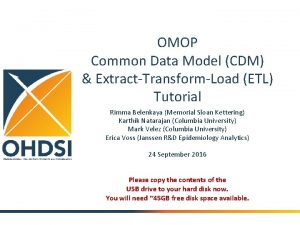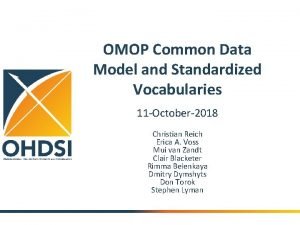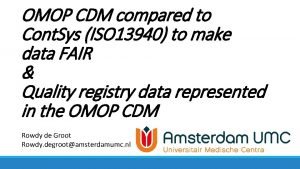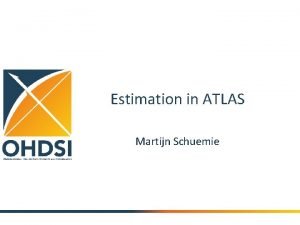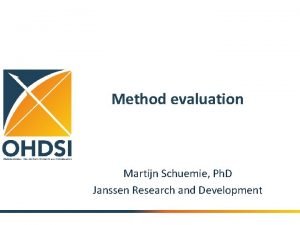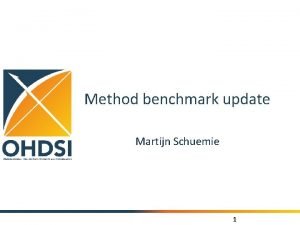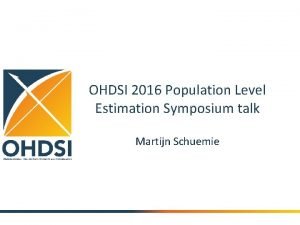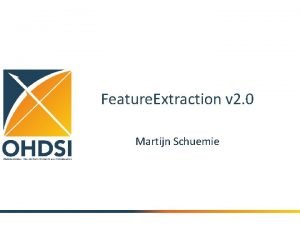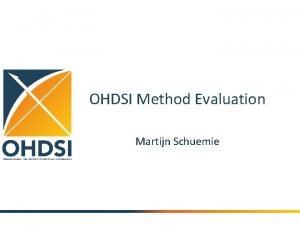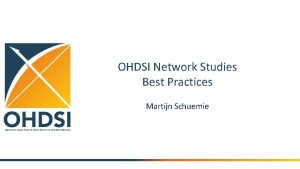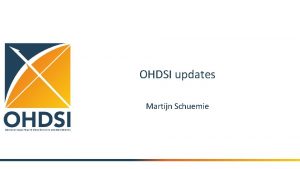An OHDSI Methods Research Agenda for 2021 Martijn















- Slides: 15

An OHDSI Methods Research Agenda for 2021? Martijn Schuemie

OHDSI Steering Committee • A more top-down approach for 2021? • Distinction: – Workgroups: do work to advance OHDSI’s goals – Special Interest Groups: convene to discuss topics of common interest 2

Top-down Our Mission • To improve health by empowering a community to collaboratively generate the evidence that promotes better health decisions and better care. 3

Probable 2021 OHDSI goals Generate evidence on the effects of all medicines for specific diseases • COVID-19 (treatments vaccines) • Type 2 Diabetes Mellites 4

Possible 2021 Methods Research Topics • Characterization (What happened to them? ) • Population-Level Effect Estimation (What are the causal effects? ) • Patient-Level Prediction (What will happen to me? ) 5

Possible characterization research topics Accurate population rates / proportions “How many people in the population experienced X? ” Example: Narcolepsy incidence rate (IR) • OHDSI cohort definition for Narcolepsy in CCAE: 25. 42 per 100, 000 patient years • Silber et al: 1. 37 per 100, 000 patient years • Silber et al, age + sex adjusted to CCAE: 1. 15 per 100, 000 patient years Assuming for argument’s sake that sensitivity = 100%, our PPV would be 4. 5% 6

Possible characterization research topics Accurate population rates / proportions Typically, we don’t have a gold standard. How to establish operating characteristics? - Phe. Valuator - Manual annotation of patient profiles (possibly guided by predictive models) 7

Possible characterization research topics Accurate population rates / proportions To evaluate these approaches, we need a gold standard. What would make a good gold standard? • Highly accurate incidence / prevalence rates (e. g. census? ) • Stratified by age, sex, and geography so we can (somewhat) adjust for differences Plan: • Establish gold standard of incidence / prevalence rates • Run cohort definitions • Run approach to establish operating characteristics (e. g. Phe. Valuator) • Compute incidence / prevalence rates, adjusting for operating characteristics • Compare to gold standard 8

Possible effect estimation research topics Analyses across databases with small sample sizes (Was supposed to be finished in 2020) • Combine estimates across databases when counts are low or zero, without sharing patient-level information (done) • Better metrics for computing covariate balance • Confounder adjustment in small-sample setting. Evaluate – – Cardinality matching Disease risk scores Representation learning (creating a lower-dimensional representation) Informed priors in our LASSO (informed by PS models in larger databases) 9

Possible effect estimation research topics Evaluation of methods for vaccine safety surveillance Similar to our HDSR paper: • Create a benchmark of vaccines (e. g. flu vaccines) and corresponding negative control outcomes • Synthesize positive controls • Apply a suite of methods, e. g. – Poisson Maximized Sequential Probability Ratio Test (PMax. SPRT) – Comparative cohort analysis with a non-user comparator – SCCS / Self-controlled Risk Interval (SCRI) • Compute performance metrics High priority! Target Q 1 2021? 10

Possible effect estimation research topics Benefit-risk framework Single outcome multiple outcomes (e. g. LEGEND) Hard to compare on hazard ratio scale Compute absolute risks instead - Requires accurate incidence / prevalence rates - Some fancy statistics Account for seriousness of outcome Suchard et al. , 2019 11

Possible prediction research topics Using predictive models to generate expected rates for vaccine surveillance … 12

Possible prediction research topics Empirical evaluation of design choices (ongoing) • Optimal predictor lookback window (almost done) • Combining estimators from different DBs (almost done) • … 13

Possible prediction research topics Improving adoption of predictive models Are the COVER models being used in clinical practice, and if not, why not? 14

Wrapping up • Do we want to be a workgroup or a special interest group? • Interest in pursuing joint research agenda? • Available resources? – OHDSI student group? 15
